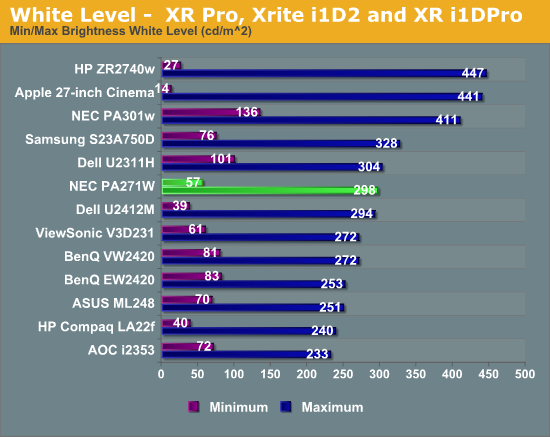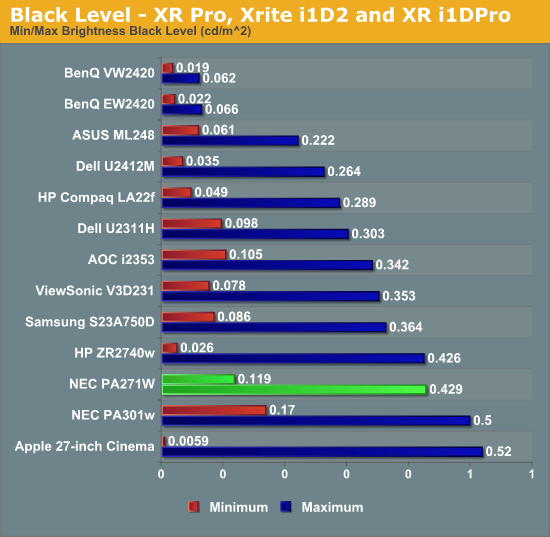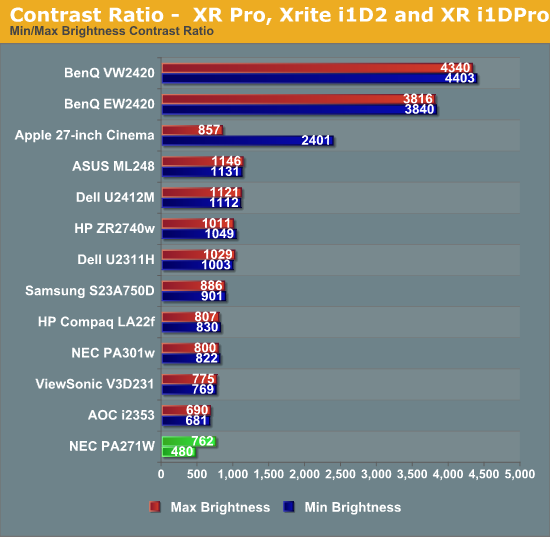NEC PA271W - When Accuracy and Consistency Matter
by Chris Heinonen on May 1, 2012 1:55 PM ESTNEC PA271W - Brightness and Contrast
The NEC is rated fairly conservatively at only 300 nits of light output at maximum, though for a professional work environment that is likely more than anyone would need. The OSD for the NEC lets you know the light output in cd/m^2 (which is equivalent to nits) as you raise and lower the value, and once you move past 250, the color changes to let you know you’re going beyond where the screen uniformity measurements can help you. Driven to the maximum output, the screen might read 400 cd/m^2 but the actual value was far less than that.

As we can see, we managed right around the maximum value of 300 nits, so that conservative estimate is right on in this case. The OSD might not indicate the correct value once you move past the recommended 250 cd/m^2 level, but below that it seemed to be within 3-4% of the listed value which was pretty good. You can see the lowest light output level was down to 57 nits, which means you can adjust the display to be dim enough for any work environment you might have.
Of course, with our accurate white levels we have to hope that we get good black levels as well, which has not been the high point for IPS screens with CCFL backlights, as opposed to LED dimming setups, in the past.

Unfortunately our black levels do leave a bit to be desired. The level at the minimum is 0.119, and I’d hope for something closer to 0.050 or less, and the maximum level was 0.429, which looks closer to a dark gray than black at that level. These indicate that our contrast ratio probably is going to leave a bit to be desired with the NEC.

As we could guess, the contrast ratio with the minimum backlight is only 480:1, and it rises up to 762:1 with the monitor at maximum output. With the wide swing between these two values I went ahead and measured the contrast ratio at our calibrated 200 nits setting and found it was 561:1, so the ratio improves as the light output level increases. It seems there is a minimum amount of light that the IPS panel is going to let through, which could be related to the screen uniformity technology used by NEC on the display, but you should be aware that if you want deep, dark blacks you’ll need to look for a different display using either a different panel technology, a different backlighting technology, or both.










69 Comments
View All Comments
B3an - Wednesday, May 2, 2012 - link
2560x1440 instead of 2560x1600 on a high end LCD? Disgraceful. Should be 16:9 ratio!Most people by far will be using this for colour important work, graphic design and so on, not for watching fucking movies. Those extra vertical pixels are important, not to mention better for just about anything else, including viewing web pages.
TegiriNenashi - Wednesday, May 2, 2012 - link
The price for 2560x1600 is insane, even for ebay imports from Korea. No matter how badly ones love tall monitors it is hard to justify spending $1000 vs $350 for 11% increase in screen space. Now that 4K aka QuadHD is on horizon, it's much better strategy to shell small amount and upgrade to 4K later. It is sad that 16:10 and taller AR doesn't seem to be coming back...ggathagan - Wednesday, May 2, 2012 - link
Uh.. you got it backwards, Skippy.2560x1440 *is* 16:9
2560x1600 is 16:10
ozmia - Wednesday, May 2, 2012 - link
I like how this review seems to utterly ignore Dell's U2711? It not only has exceptional colour accuracy straight out of the box in the factory configured modes, but very respectable input lag for a 27" screen, and apart from work, I use it for games and it is fantastic.I don't think you have been particularly non-biased, Chris, and this review has a strong wiff of the favouritism.
The U2711 is probably superior to the HP in most ways bar input lag, yet it does not even get a look in. Very poor indeed.
cheinonen - Thursday, May 3, 2012 - link
Someone else wrote the U2711 review, and I've never had the opportunity to use one myself. Any comparisons I make between the two would only be based on my reading of reviews of the display and not from actual use, which is why I didn't mention it.nurfe - Thursday, May 3, 2012 - link
Did you read the review? The two monitors are in two completely different classes. NEC has a 14 bit lookup-table, hardware calibration, electronically corrects uniformity and colour distribution problems etc. The Dell is a normal ISP office monitor.bishop2020 - Thursday, May 3, 2012 - link
I've read both this review and the earlier U2711 review that Anandtech did and would disagree that they aren't comparable.Uncalibrated DE - Dell 2.24, NEC 7.07.
Calibrated DE - Dell 1.06, NEC 1.1.
AdobeRGB - Dell 96%, NEC 106%.
I'm not saying the NEC isn't a better monitor, I actually wholly agree with you on that point, but to say it's in a different class and not worth comparison seems a tad elitist. Many professionals don't work in AdobeRGB (see http://www.kenrockwell.com/tech/adobe-rgb.htm) and many don't have access to calibration equipment so a lower shipping DE may be something they're more interested in.
As someone who uses a professional 27" monitor daily I have no problem lumping the Dell & HP in with the NEC & Eizos of the world if only for additional data points even if I don't expect them to come out on top (though I make no assumptions that they can't be superior). The requirements you or I might put on a monitor don't necessarily apply to everyone and seeing the comparisons helps people make informed decisions. That said, I respect the author's decision not to include any direct comparison due to lack of first-hand experience in reviewing the Dell.
nurfe - Friday, May 4, 2012 - link
But that's entirely my point. Using a professional monitor without setting it up correctly, and wihout taking full advantage of its features doesn't make any sense. Of course you'll get similar result buying something else, like a Dell, since you're ignoring the premium features you just paid for.Thus, I very much diasgree that finding the common lowest denominator is ground for a comparison.
bjnicholls - Wednesday, November 28, 2012 - link
OMG, Ken Rockwell on displays? Next I'll see him referenced as an expert on toaster ovens.A professional who isn't provided or can't afford calibration tools isn't a very valuable or valued professional. You need wide gamut if you design for print. But even more, you need a display that has color and luminance uniformity so you can view and work with reasonable precision on large images and designs.
I just returned a Dell U3011 display because it had an obvious color shift across a third of the display. And looking at uniform background colors, it had really poor luminance consistency. At least compared to my aging NEC 3090 display.
I was hoping that a Dell would be "good enough" for design and image editing, but I'm back to finding the best buys I can get on NEC displays. The difference is not subtle and if your work requires consistent, accurate color you should at least aspire to a display designed to deliver the performance you need.
It's interesting that people who spend thousands of dollars on cameras and lenses with excellent image capture capability will cheap out on the one most critical tool they need to view and work with those images. It's like having a professional audio studio but listening to the sound via a cheap sound system.
xKeGSx - Wednesday, May 2, 2012 - link
Any word on the VA278q that was announced at CES 2012?